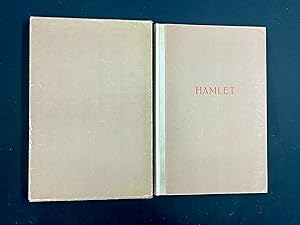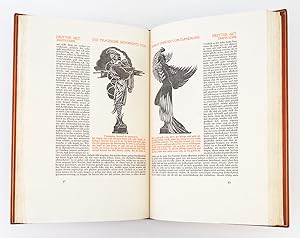Cranach Press Shakespeare William (4 results)
FeedbackSearch filters
Product Type
- All Product Types
- Books (4)
- Magazines & Periodicals (No further results match this refinement)
- Comics (No further results match this refinement)
- Sheet Music (No further results match this refinement)
- Art, Prints & Posters (No further results match this refinement)
- Photographs (No further results match this refinement)
- Maps (No further results match this refinement)
- Manuscripts & Paper Collectibles (No further results match this refinement)
Condition Learn more
- New (No further results match this refinement)
- As New, Fine or Near Fine (1)
- Very Good or Good (No further results match this refinement)
- Fair or Poor (No further results match this refinement)
- As Described (3)
Binding
- All Bindings
- Hardcover (3)
- Softcover (No further results match this refinement)
Collectible Attributes
- First Edition (No further results match this refinement)
- Signed (No further results match this refinement)
- Dust Jacket (No further results match this refinement)
- Seller-Supplied Images (4)
- Not Print on Demand (4)
Language (1)
Price
- Any Price
- Under US$ 25 (No further results match this refinement)
- US$ 25 to US$ 50 (No further results match this refinement)
- Over US$ 50
Free Shipping
- Free Shipping to U.S.A. (No further results match this refinement)
Seller Location
Seller Rating
-
Die Tragische Geschichte von Hamlet Prinzen von Daenmark in deutscher Sprache. Facsimile edition.
Published by Cranach Press. New York: Benjamin Blom,, 1972
US$ 443.78
Convert currencyUS$ 31.82 shipping from United Kingdom to U.S.A.Quantity: 1 available
Add to basketHardback. Condition: Near Fine. No Jacket. later edition. Cranach Press. William Shakespeare, Die Tragische Geschichte von Hamlet Prinzen von Daenemark in Deutscher sprache, translated by Gerhart Hauptmann, illustrated by Edward Gordon Craig, Weimar: Cranach Presse, 1929, facsimile edition, New York: Benjamin Blom, 1972, text printed in red and black on pale cream laid paper, 74 woodcut illustrations by Edward Gordon Craig, typography designed by Edward Johnston, printed in red and black in double column, 8 pp. account of the printing of the Cranach Press Hamlet in pocket to rear pastedown, top edge gilt, vellum-backed boards, lettered to spine and upper cover in orange, a Fine copy, with original slipcase some minor wear to extremities, folio.
-
Die Tragische Geschichte Von Hamlet Prinzen Von Daenmark.
Published by Printed at the Cranach Press by Henry Kessler. 1928-9, Weimar, 1928
Seller: SOPHIE SCHNEIDEMAN RARE BOOKS, ABA, ILAB, LONDON, United Kingdom
US$ 20,482.06
Convert currencyUS$ 39.77 shipping from United Kingdom to U.S.A.Quantity: 1 available
Add to basketWood engravings by Edward Gordon Craig, and wood-engraved lettering by Eric Gill, typeface designed by Edward Johnston, after that used by Fust & Schoeffer in their Mainz Psalter of 1457. The hemp and linen fibre paper was made by Maillol. No.115 of only 230 copies of the German edition. Folio, original vellum backed, salmon pink paper covered boards with lettering in red on spine and upper cover. Housed in the original card slipcase. A superb copy with only a little browning pp.14-18. Intended by Count Kessler as the crowning glory of his private Cranach Press, Hamlet was 17 years in gestation from when he had seen Gordon Craig's black figures for his Moscow Hamlet and decided that spectacular woodcuts could be printed from them. The result is one of the most important and spectacular works of the private press movement.
-
The Tragedie of Hamlet Prince of Denmarke
Publication Date: 1930
Seller: Maggs Bros. Ltd ABA, ILAB, PBFA, London, United Kingdom
US$ 37,550.44
Convert currencyUS$ 35.79 shipping from United Kingdom to U.S.A.Quantity: 1 available
Add to basketOne of 300 copies on paper, this number 88, with an additional 15 on Imperial Japanese paper and eight copies on vellum. 81 wood engravings by Edward Gordon Craig, title and half title designed and cut by Eric Gill. Titles printed in red, text in black, wood engravings in black with occasional highlights in blue. Typeface designed by Edward Johnston, after that used by Fust & Schoeffer in their Mainz Psalter of 1457 Folio, 38 x 25cm, 186pp., [2]. With Notes by J. Dover Wilson in pocket to rear as issued, 35pp. Original publisher's half vellum with pale brown paper boards, spine lettered in gilt. Weimar, Cranach Press. Fine, very slight finger soiling towards spine of upper cover. With the neat bookplate of the American theatre producer and book designer Merle Armitage. A stunningly fine copy of this landmark of 20th century fine printing, from the collection of a noted American designer who, like Kessler, combined the traditions of theatre with book illustration to great effect. Almost 20 years in the making, the Cranach Press Hamlet is one of the supreme achievements of 20th century printing. The undoubted magnum opus of both printer and artist, William Rothenstein wrote adoringly to Count Harry Graf Kessler on receiving his copy: ?I must tell you at once how magnificent I think the Hamlet. It is one of the great books? to my mind easily the most important book since Morris? Chaucer.? One contributing factor to the unique quality of the Cranach Hamlet is that its origins lay not in traditional book illustration, but rather in the world of theatre and stage design. Edward Gordon Craig had co-directed a production of Hamlet alongside Stanislavski at the Moscow Art Theatre in 1912, which would turn out to be ?a decisive event, for it opened the way to personal, often political, interpretations of Shakespeare and established the principle of conceptual staging?? (Lindsay Newman, The Book as a Work of Art). Craig used mobile screens of canvas and wood onto which were projected coloured lights and forms, and made use of wooden figures which he cut himself from planks, producing semi-abstract scenes of great interpretive and emotional power. Kessler recalled visiting Craig in 1911 when he was living ?in a small, old house in Smith Square, a ?haunted house?, as he said? where ?he shewed me his new scenery, a series of screens taking on every shape and mood merely by moving and lighting them differently, and some very wonderful little wooden figures for Hamlet. He is a crazy creature, but a man of supreme genius in his own art? The performance inspired Kessler, but even more important ?were the drawings and prints which he produced afterwards. He has made pulls on paper from his wooden figures, which can take their place beside the most beautiful woodcuts of the quattrocento, so perfect is their balance between line and meaning, between inner fire and fascinating decorative effect? It was this realisation, that the figures might be printed on paper as white-line woodcuts, which prompted Kessler to set about the task of printing an edition of Hamlet using Craig?s illustrations. In order to match these illustrations to type, Kessler turned to his long-serving advisor Emery Walker, who ?had convinced Kessler that type and illustration should form a unity in weight, style, and layout. His starting point was the typeface, which he believed should be monumental and simple, and which should set the tone for the illustrations? (Lindsay Newman). For this they looked to the veteran calligrapher and type designer Edward Johnston, who was commissioned in 1912 to make designs for a black letter fount based on Fust and Schoeffer?s Mainz Psalter of 1457, making use of photographic enlargements made by Walker after copies at the British Library. The resulting designs were, almost inevitably, cut by the punchcutter Edward Prince, from whom had also flowed the types of Morris, Hornby and Cobden-Sanderson. The resulting ?black letter type can b.
-
DIE TRAGISCHE GESCHICHTE VON HAMLET PRINZEN VON DAENMARKIN DEUTSCHER SPRACHE
Published by Cranach Press 1928 (copyright 1929), Weimar, 1928
Seller: Phillip J. Pirages Rare Books (ABAA), McMinnville, OR, U.S.A.
365 x 242 mm. (14 1/4 x 9 1/2"). 202 pp., [1] leaf.Translated by Gerhart Hauptmann. FINE ORIGINAL BURNT ORANGE MOROCCO by O. Dorfner of Weimar (signed on rear turn-in), covers with single gilt-ruled border, raised bands, spine compartments ruled in gilt, gilt spine titling, turn-ins ruled in gilt, top edge gilt, other edges untrimmed. In a fine matching morocco-lipped slipcase lined with fleece. Illustrated throughout with woodcuts in the text by Edward Gordon Craig; this copy WITH TWO FULL-SIZE VELLUM LEAVES CONTAINING PRINTED WOODCUTS AND SIGNED BY CRAIG laid in. Printed in red and black. With the Hamlet stories from Saxo Grammaticus and Belleforest in Latin and French in margins surrounding the text. With Prospectus laid in at front. Schröder, p. 9; Franklin, p. 164; Ransom, p. 253; "A Century for the Century" 21 (English version). âSpine gently and evenly sunned to a less reddish brown, traces of white residue from leather preservative to front board, but AN ESPECIALLY FINE COPY, the binding unworn, and IMMACULATE INTERNALLY. A deservedly famous combination of visual daring, printing artistry, and textual scholarship, this is one of the major achievements of private press printing. Undertaken in what Franklin calls "a perfectionist spirit," the book brings together the most glittering names in English and German private printing at the time. In addition to the presence of the woodcuts by Craig, the typographical arrangement of the volume was done by Count Harry Kessler, the title was cut by Eric Gill, the type (in 18-, 12-, and 10-point black letter) was designed by Edward Johnston after that used by Fust and Schoeffer in their Mainz Psalter of 1457, and was cut by Edward Prince (completed after his death by G. T. Friend), and the paper was made by a process devised jointly by Kessler and Aristide and Gaspard Maillol. Franklin says that "anybody who examines the Cranach Press 'Hamlet' must agree it is worthy of its reputation. The paper, superficially like Bachelor's Kelmscott, seems softer and more friendly, appropriate for the expressionist style of Craig's woodcuts. . . . These designs, and Gill's in the Golden Cockerel Chaucer, form the bravest artistic adventure among all private press books." It is increasingly difficult to find well preserved copies of this title, especially in Otto Dorfner bindings. Master binder Dorfner (1885-1955) taught at the School of Applied Arts in Weimar and at the Bauhaus school before founding his own to teach the craft. He was awarded a number of international awards for his bindings, and is particularly noted for his work with the Cranach Press. Dorfner was held in high enough esteem to merit inclusion on the Nazi's"Gottbegnadeten List"("God-gifted list" or "Important Artist Exempt List") of artists essential to Nazi culture. This 36-page list, assembled in September 1944 byJoseph Goebbels andAdolf Hitler, exempted the named artists from mobilization in the final stages of World War II. No. 8 OF 230 COPIES ON HANDMADE PAPER, of a total edition of 255.





